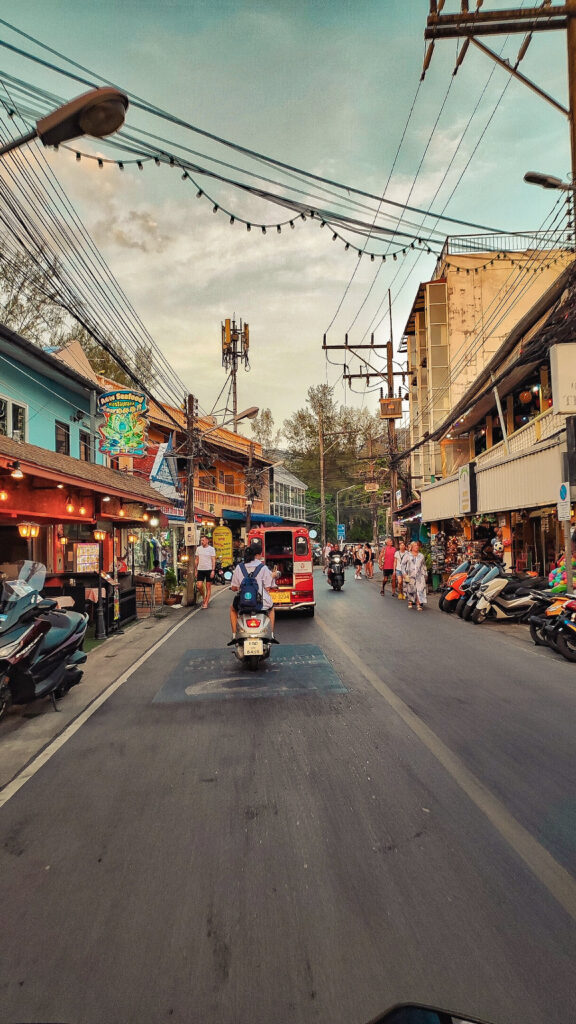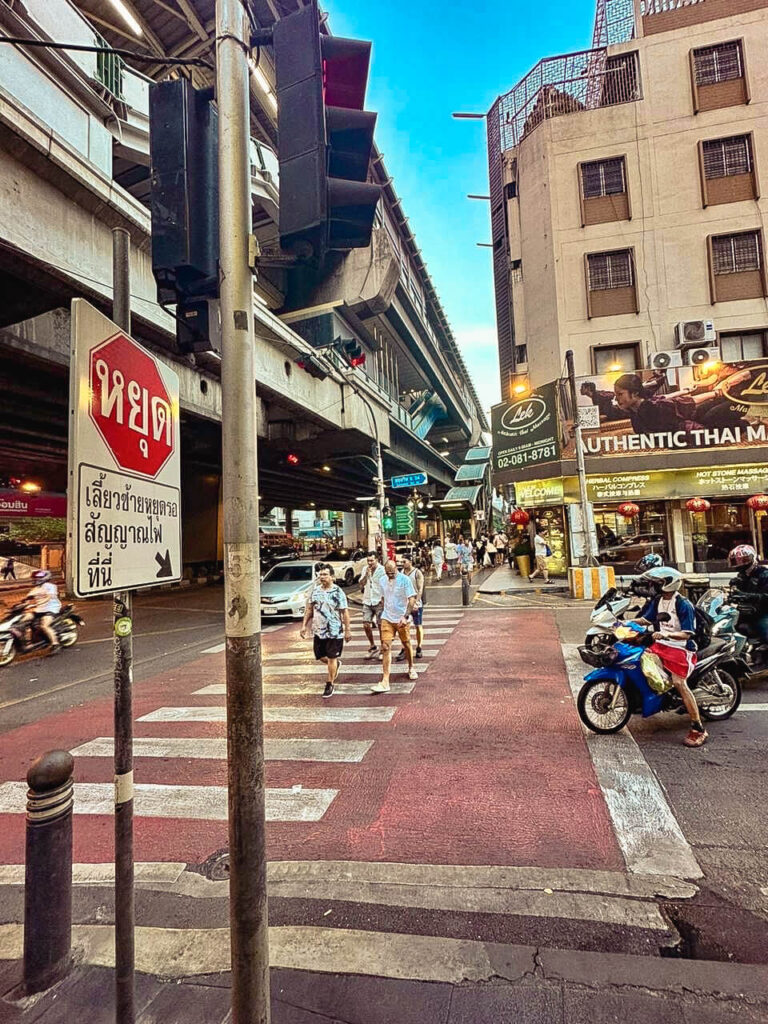Best Time to Visit Thailand. Weather & Climate by Month
Thailand stands out as a top destination for backpackers, culture lovers, and digital nomads year-round. However, the country’s seasons exhibit significant variations from region to region and coast to coast. Let’s delve into the seasonal intricacies of each area to assist you in pinpointing the best time to visit Thailand based on your travel preferences!
Nestled at the heart of mainland Southeast Asia, Thailand offers a captivating allure for most of the year. To skirt around monsoon rains and the smoky season, a little pre-trip research and planning can go a long way in ensuring you visit the right places at the most opportune times.
This is where I come in!
Thailand features a diverse landscape that transitions from the northern mountains to the southern islands, resulting in a broad spectrum of climates across the country. Unlike the conventional winter-spring-summer-autumn sequence, Thailand’s seasons are best characterized as “cool,” “hot,” and “rainy.”
In this guide, I will break down the seasonal nuances of each region, empowering you to determine the best time to visit Thailand based on your desired experiences and activities during your trip.
When is the Best Time to Visit Thailand?
For the most part, the period from November to February promises the most pleasant temperatures across Thailand, coupled with minimal rainfall.
Let’s delve deeper into each region:
Bangkok and Chiang Mai
The optimal weather conditions in Bangkok and Chiang Mai typically span from November to February. Beyond these months, brace yourself for heavy downpours, scorching heat, and the prevalence of smoke in the northern region.
Andaman Sea
When planning a trip to the Thai islands along the Andaman Sea (Thailand’s southwest coast), aim for the period between November and April for favorable conditions. Monsoon season, lasting from May to September in this area, signals a time best avoided due to inclement weather.
Thailand’s Gulf Coast
Thailand’s Gulf Coast showcases its finest weather from December to March, although the months of July to September also offer decent conditions with fewer crowds. The monsoon season in this region is notably shorter than in the Andaman Sea, typically occurring from October through the end of November.
Determining Your Travel Time
Selecting the ideal time to visit Thailand hinges on various factors. To assist you in this decision-making process, I’ve meticulously categorized Thailand’s seasons by region in this guide.
Each section highlights key activities and attractions, aiding you in pinpointing the perfect time to embark on your Thai escapade that aligns with your preferences and priorities.
Generally, if you’re looking for Thai food and the most pleasant temperatures, months between November – February are just great to go.
Now, let’s break it down by region…
Bangkok and Chiang Mai
Months between November – February is the best time to visit Bangkok and Chiang Mai. The north of the country experiences lots of smoke, and sometimes heavy rains and extreme heat, outside of these months.
Andaman Sea
The best time to visit Thailand’s southwest coast is November – April. This region experiences monsoon season in May – September, so it is better to avoid it if you don’t like heavy rains with notable overnight dumps.
Thailand’s Gulf
When it comes to exploring Thailand’s Gulf Coast, you can expect great weather from December – March. However, the summer months (July – September) are also a decent time to visit. While crowds tend to be fewer, the rainy season in the Gulf is much shorter than the Andaman Sea. It generally lasts from October through the end of November.
Best Time to Visit Thailand. Weather & Climate by Month
As with any destination, there is no one-size-fits-all answer. But I’m not going to leave you hanging.
In this post, I’ve structured Thailand’s seasons by region and highlighted some of the top activities to engage in during each season throughout Thailand. By perusing these recommendations, I trust that you will be able to determine the best time to visit Thailand.
To begin your Thailand travel planning, consider the following questions:
- Which region of the country are you intending to explore?
- Are you comfortable with some rainfall during your trip?
- Do you prefer to avoid crowded places?
- Does high humidity bother you?
- Is outdoor hiking a preferred activity for you?
- Are you planning to engage in scuba diving activities while in Thailand?
- Reflecting on these questions will aid in determining the ideal time to visit Thailand based on your preferences and priorities.
Thailand Weather Overview
Thailand’s weather patterns vary across regions, with significant temperature fluctuations in the north and relatively stable conditions closer to the equator in the south.
The country predominantly experiences a tropical climate characterized by warm temperatures year-round, except in the mountainous northern areas.
Thailand’s seasons fall into three main categories: Cool, Hot, and Rainy.
Cool Season
November to February; typically peak tourist season.
Hot Season
March to May.
Rainy Season
June to October.
The cool season is notably pronounced in the far north, while temperatures remain relatively stable in the south.
During the hot season, dry conditions prevail, especially in central and northern regions, often leading to the accumulation of dust particles in the air.
The rainy season is triggered by the southwest monsoon, known for its unpredictability. The Gulf Coast is less affected by the southwest monsoon and more influenced by the northwest monsoon, making November the wettest month in this region.
Below, I have detailed the seasonal breakdown by region to offer you a clearer understanding of the climate conditions in specific regions.
Northern Thailand Seasons
Northern Thailand typically experiences lower humidity levels and the widest range of temperatures throughout the year.
In January, Chiang Mai sees an average low temperature of 59ºF (15ºC). Conversely, during the hot season, the northern region becomes arid, dusty, and temperatures can soar.
- Hot Season: February – April;
- Rainy Season: May – September;
- Cool Season: October – January;
Packing Essentials for Northern Thailand
- Plenty of layers for fluctuating temperatures;
- Sturdy hiking shoes;
- Swimwear for pool and waterfall visits.
Central Thailand Seasons
Central Thailand evenly encounters the country’s three seasons throughout the year, with humidity being a constant factor that accentuates the heat.
- Hot Season: March – June;
- Rainy Season: June – October;
- Cool Season: October – February.
Packing Essentials for Central Thailand
- Loose, breathable clothing and layering options;
- Shawl or scarf for temple visits;
- Insulated water bottle for hydration.
South Thailand & Thai Islands Seasons
Southern Thailand maintains consistent temperatures year-round, with minimal variations closer to the equator. The region essentially has two seasons: wet and dry. The climate varies between the coasts due to distinct monsoons, as outlined below.
Optimal diving and snorkeling conditions are during the winter months. December and January are peak seasons, while February to April is ideal for spotting mantas and local whale sharks.
Phuket, Krabi & Andaman Coast (Southwest Coast)
Wet Season: April – October/early-November;
Wettest months: September and October;
Dry Season: Mid-November – March;
Koh Samui, Koh Phangan, Koh Tao (Gulf of Thailand).
Wet Season: October – December;
Rainiest months: October and November;
“Shoulder season” (less rain): January and February;
Dry Season: January – August;
Windy months: May – October.
Best Time to Visit Thailand Guide
Thailand boasts some of the most incredible beach destinations imaginable, catering to a wide range of preferences and interests. Whether you seek stunning beaches, island adventures, luxurious accommodations, jungle explorations, vibrant city life, culinary delights, warm hospitality, rich history, or vibrant nightlife and shopping scenes, Thailand offers it all and more.
With distinct dry and rainy seasons instead of the traditional four seasons, Thailand presents diverse climatic conditions across the country. Thus, understanding weather patterns by month is crucial for determining the best time to visit Thailand.
With sunshine gracing its beaches throughout most of the year, Thailand welcomes visitors virtually year-round. Assessing the weather in each region is essential for planning your ideal itinerary, considering the unique climatic characteristics of Northern Thailand, Bangkok, the Andaman Coast, and the Gulf of Thailand.
Overview of Different Areas
- Northern Thailand: Chiang Mai, Chiang Rai, Pai;
- Bangkok: Bangkok, Ayutthaya, Erawan National Park;
- Andaman Coast: Phuket, Khao Lak, Krabi, Koh Phi Phi, Koh Yao Noi, Koh Yao Yai, Koh Lanta, Khao Sok National Park;
- North Gulf of Thailand: Koh Chang, Koh Kood;
- South Gulf of Thailand: Koh Samui, Ko Tao.
Consider this scenario: You may be eyeing a visit to the west coast islands during summer, only to realize it’s the rainy season there.
However, on the east coast islands, the rainy season might be absent. Feeling perplexed? Fear not! I’ll demystify everything you need to know about Thailand’s weather patterns.
In general, the dry season spanning from November to April stands out as the prime period to explore Thailand’s beaches. The one window I suggest avoiding is late September to October when the country typically experiences the most intense rainfall of the season.
Let’s delve into a detailed exploration of Thailand’s weather month by month, pinpointing the best time to travel to Thailand beaches!
Thailand Weather in January
Curious about the best time to travel to Thailand beaches in January?
Here’s the scoop:
In Bangkok, temperatures hover around 28°C (82°F) with minimal rainfall (though brace for Bangkok’s perennial hot and humid conditions).
Embark on an adventure in Northern Thailand’s jungle heartland encompassing Chiang Mai and Chiang Rai, where rainfall is scarce, and temperatures average a pleasant 20°C (68°F).
January is a prime window to explore the Andaman Coast Islands like Phuket, Khao Lak, Krabi, and Phi Phi, boasting average temperatures of 28°C (82°F) with sporadic, brief showers if any.
While the Gulf of Thailand might witness scattered showers during this period, they are typically short and occur infrequently (less than 10 days of rain in the month).
Whether you’re contemplating hidden gems like Koh Kood or popular destinations like Koh Samui, January presents a favorable climate for your escapades.
As January emerges as the best time to book flight to Thailand, prices tend to peak. Especially in the early month surrounding the Christmas and New Year holidays. Securing bookings early ensures top availability and competitive rates.
Thailand Weather in February
February emerges as the best time of year to visit Thailand. This month ranks among my personal favorite months for its warm and dry climate prevailing across the nation!
Bangkok
While historical averages hover around 28°C (82°F), anticipate slightly warmer temperatures in this bustling city. With minimal rainfall during this period, the conditions are perfect for immersing yourself in the city’s vibrant atmosphere.
Northern Thailand
Venture up country to Chiang Mai and Chiang Rai, where the verdant landscapes showcase an average temperature of 23°C (75°F). Experience scant rainfall, making it an ideal time to visit elephant sanctuaries, trek to waterfalls, and explore rural villages.
West Coast Gems
February stands out as one of the best times to visit the Andaman Coast wonders such as Phuket, Krabi, Khao Lak, and mesmerizing islands like Koh Yao Noi, Koh Phi Phi, and Koh Lanta. Revel in the stunning island panoramas under sunny skies, with temperatures averaging 27°C (81°F).
Gulf of Thailand Islands
Islands like Koh Samui, Koh Phangan, and Ko Tao transition into the dry season during February, boasting minimal rainfall and an average temperature of 27°C (81°F).
Northern Gulf of Thailand Islands
In locales like Koh Chang and Koh Kood, sunny days prevail with scarce rainfall. Any showers that do occur are fleeting in nature.
Given that February ranks among the best time to visit Thailand for good weather, I advocate securing bookings early. By doing so, you can secure the best availability and competitive prices for your trip.
Thailand Weather in March
Is March the best time to visit Thailand? Without a doubt! March shines as the prime period to visit Thailand, offering dry and sunny conditions throughout the nation.
Bangkok
Historically averaging 29°C (85°F), Bangkok can experience even higher temperatures during this time. With minimal rainfall, March provides the perfect opportunity to explore iconic sites like the Grand Palace and Buddhist temples.
Northern Thailand
Cities like Chiang Mai, Chiang Rai, Pai, and the Golden Triangle witness a slight rise in temperatures, maintaining a pleasant 27°C (81°F) with minimal rainfall. These regions serve as true gems of Thailand, making them a must-visit for travelers in March.
Andaman Coast Islands
Islands like Phuket, Krabi, Khao Lak, and neighboring ones bask in near-perfect weather conditions. Expect average temperatures of 28°C (82°F) with minimal rainfall, ideal for island exploration and relaxation.
Eastern Islands
March also offers low rainfall on the eastern side of Thailand. Whether you’re yearning to explore Koh Samui, dive in Koh Tao, revel in the full moon party on Koh Phangan, or venture to the northern Gulf of Thailand islands, this month presents an opportune time to visit.
As March is the best time to go to Thailand for full moon party, and potential Easter celebrations, I suggest booking early to secure prime availability and favorable prices. Traveling outside the Easter period, if feasible, not only helps you save money but also allows you to savor the attractions without the bustling hordes of tourists.
Thailand Weather in April
April marks a transitional phase in Thailand, yet it remains the best time of the year to visit Phuket, Thailand.
Bangkok
The bustling city remains hot and humid throughout the year, with temperatures averaging around 30°C (86°F) and often feeling even hotter.
Northern Thailand
Amidst the captivating junglescapes of Chiang Mai and Chiang Rai, temperatures rise to an average of 29°C (85°F) in April. While the occasional shower may occur, rainfall remains minimal during this period, gradually increasing as the month progresses.
Gulf of Thailand Islands
Down south, indulge in sun-soaked days on islands like Koh Samui, where only about 5 days of April witness light rain showers.
West Coast Islands
Transitioning from the dry season to the rainy season, destinations like Phuket and Krabi experience isolated showers that gradually become more frequent. Approximately 11 days in April may feature sporadic rain showers, yet the overall ambiance remains relatively dry.
Wondering if April is a good time to visit Thailand? Absolutely! Just be prepared for intermittent showers and thunderstorms.
Furthermore, April coincides with the popular Easter break, adding to Thailand’s allure as a sought-after destination during this period.
Given April’s reputation as the best time to vacation in Thailand, I advise getting your tickets early allows to secure the best availability and prices, especially if you can plan your travel outside the two-week Easter period.
Thailand Weather in May
May heralds the beginning of Thailand’s rainy season, making it a less favorable time for going to Thailand for good weather. Generally, there are indeed more favorable months for travel.
Bangkok
The capital city experiences hot and humid conditions in May, with temperatures averaging 31°C (88°F). Approximately 17 days of the month witness some rainfall, often manifesting as heavy downpours or showers.
Northern Thailand
Areas like Chiang Mai and Chiang Rai also encounter similar weather patterns, with over half the days in May experiencing rainfall.
Andaman Coast Islands
Favorites like Phuket, Krabi, Khao Lak, and islands such as Phi Phi encounter the third highest rainfall of the year during this month. While not a constant downpour, showers can be intense and accompanied by thunderstorms. This period may present opportunities for snagging budget-friendly luxury hotel deals.
East Coast Islands
Opting for destinations like Koh Samui, Koh Phangan, and Koh Tao on the east coast proves more promising in May. Although showers may occur in the Gulf of Thailand islands, they are usually less severe compared to the west coast. For instance, Koh Samui typically receives 150mm of rain on average, significantly less than Phuket’s 350mm.
May can be the best time to go to Thailand for party themes if you don’t mind occasional rain and are keen on enjoying lower prices and fewer crowds.
Thailand Weather in June
June signifies the advancement of the rainy season, meaning it’s not the best time to visit Golden Triangle in Thailand.
Bangkok
The climate in Bangkok remains humid and hot in June, with average temperatures around 31°C (88°F). Expect roughly 18 days of rainfall, often appearing as brief showers or heavy downpours.
Northern Regions
Areas like Chiang Mai and Chiang Rai also witness a similar weather pattern, with more than half of June’s days experiencing rainfall.
Andaman Coast
June marks the peak of the rainy season in popular spots like Phuket, Krabi, Khao Lak, and the Phi Phi Islands. While continuous rain is uncommon, expect sudden and intense downpours. This off-peak season presents excellent discounts on accommodations.
East Coast Islands
For travelers eyeing a trip to Thailand in June, opting for the east coast islands like Koh Samui, Koh Phangan, and Koh Tao proves to be a wiser choice. The Gulf of Thailand experiences lighter showers, with rain occurring only about 1 in every 4 days of the month.
June emerges as the best time to visit Thailand if you are comfortable with occasional rain and seek budget-friendly prices and fewer crowds. For the most favorable weather conditions, prioritize exploring the east coast islands.
Thailand Weather in July
July marks the continuation of the rainy season in the Land of Smiles, making it not the best time to visit Thailand. However, it remains popular due to being a peak month for global tourism.
Bangkok: The climate in Bangkok lingers as warm and humid in July, with temperatures averaging around 31°C (88°F). Approximately 19 days in July will witness rainfall, typically appearing as sudden, short, intense downpours.
Northern Regions
Places like Chiang Mai and Chiang Rai encounter rain on around 21 days of July, making it less than ideal for activities like jungle trekking.
Islands
Across the islands, temperatures remain stable at around 31°C (88°F).
Andaman Coast
Favorite destinations like Phuket, Krabi, Khao Lak, and the Phi Phi Islands face some of the rainiest moments of the year in July. While continuous rain is unlikely, expect robust and sudden showers and thunderstorms during this time.
Eastern Islands
Travelers planning a July visit to Thailand may find the eastern islands such as Koh Samui, Koh Phangan, and Koh Tao more suitable. These islands normally experience less rainfall compared to their western counterparts. For example, Koh Samui witnesses half the average rainfall seen in Phuket during July.
Northern Gulf Islands: Don’t overlook the charm of northern Gulf of Thailand islands like Koh Kood and Koh Chang for a unique experience.
July is the best time to visit Thailand if you are comfortable with occasional rain, seeking budget-friendly prices, and aiming to avoid large crowds. For a better weather experience, prioritize the eastern islands.
Thailand Weather in August
August finds the country deeply entrenched in the monsoon season, making it not the best time to visit Thailand for those seeking dry weather conditions.
Bangkok
The capital city retains its warm and muggy climate in August, with average temperatures hovering around 31°C (88°F). Anticipate approximately 17 days of rainfall, usually characterized by brief yet heavy downpours.
Northern Regions
Areas like Chiang Mai and Chiang Rai reflect a similar weather pattern in August, with most days experiencing rain, high humidity, and thunderstorms.
West Coast Islands
On the islands of the west coast, including popular spots like Phuket, Krabi, Koh Lanta, and the Phi Phi Islands, August marks one of the peak rainy months. While continuous rainfall is infrequent, showers are often intense and sudden. Great hotel deals can be found, but be ready—around 23 days of the month may see rain.
Eastern Islands
For travelers contemplating a Thailand excursion in August, opting for the eastern islands such as Koh Samui, Koh Phangan, and Koh Tao proves wise. These Gulf of Thailand islands typically experience less severe rainfall compared to the west coast, with Koh Samui receiving about half the rainfall of Phuket in August.
August is the best time to visit Thailand if you are comfortable with occasional rain, seek budget-friendly prices, and prefer fewer crowds. To enjoy more favorable weather conditions, consider directing your attention to the east coast islands during this period.
Thailand Weather in September
While September isn’t regarded as the best time to visit Thailand overall, it offers unique experiences depending on the region you choose to explore.
Bangkok
September marks the rainiest month in Bangkok, with heavy rainfall prevailing most days. Temperatures average around 30°C (86°F).
Northern Thailand
Similar to Bangkok, Northern regions like Chiang Mai, Chiang Rai, and Pai experience heavy rainfall in September, making it the wettest month and less than ideal for jungle adventures.
Andaman Coastline
Areas like Phuket, Phi Phi Islands, Krabi, Koh Lanta, and Khao Lak witness the highest rainfall of the year in September, with an average of 400mm. Temperatures typically hover around 27°C (81°F).
Gulf of Thailand Islands
On the west coast islands of the Gulf of Thailand, September marks the end of the dry season. Koh Samui, Koh Phangan, and Koh Tao may experience some showers, but less than half of the month’s days. However, heavy monsoon rains often arrive later in the month.
Considering a comprehensive exploration of Thailand in September may not be ideal. Alternatively, Bali could be a suitable choice as it’s the dry season there.
September can be the best time to visit Thailand if you are comfortable with rain, seek budget-friendly prices, and prefer fewer crowds. Opting for the east coast islands offers the best weather during this month.
Thailand Weather in October
To be straightforward, October is not the best time to visit Thailand. Actually, it stands out as the rainiest period throughout the country.
Bangkok
While the rainfall in Bangkok is not as severe as the previous month, heavy showers are still expected. October sees average temperatures around 28°C (83°F).
Northern Regions
In places like Chiang Mai and Chiang Rai in the north, rainfall diminishes compared to September, making later in the month less prone to heavy downpours.
Andaman Coast
Areas like Phuket, Krabi, and Khao Lak witness an average temperature of around 27°C (81°F) in October, but rain is prevalent most days of the month. The precipitation can vary from regular thunderous downpours to occasional showers.
Gulf of Thailand Islands
Islands such as Koh Chang and Koh Samui in the Gulf of Thailand face some of the most substantial rainfall of the year. While temperatures average around 28°C (82°F), over half of the month typically experiences rainy days, ranging from daily showers to continuous rainfall.
Although October might not be the best time to visit Thailand due to the heavy rainfall, September remains a more favorable month for those comfortable with rain.
Thailand Weather in November
November signifies a transitional phase in Thailand’s climate.
Bangkok
Temperatures hover around 27°C (81°F) in Bangkok, occasionally feeling hotter. With minimal rainfall, November presents an excellent opportunity for sightseeing, shopping, and revelry.
Northern Regions
In areas like Chiang Mai and Chiang Rai, weather conditions have improved from the previous month. While sporadic showers may occur, temperatures have decreased to an average of 25°C (77°F), offering a delightful period to delve into Thailand’s rural landscapes.
Southern Beach Areas
Along the Andaman side encompassing Phuket, Krabi, and stunning islands like Phi Phi and Koh Yao Noi, the tail end of monsoon rains persists. Expect some rainy days, with about half of November witnessing showers gradually clearing as the month progresses.
West Coast Islands
Transitioning from the dry season to the rainy season, regions like Phuket and Krabi on the west coast experience isolated showers becoming more common as the month advances. Approximately 11 days in November may feature occasional rain showers, but overall, it remains relatively dry.
East Coast Islands
November marks the wettest month for islands like Koh Samui and Koh Phangan. Koh Samui encounters double the rainfall of Phuket during this period, suggesting that opting for west coast islands could be preferable in November.
Northern Gulf Islands: Consider exploring islands like Koh Chang and Koh Kood in the northern Gulf of Thailand, which receive less rainfall compared to other regions.
While pondering if November a good time to visit Thailand, be prepared for sporadic showers and thunderstorms amidst the transitional weather patterns.
Thailand Weather in December
If you’re wondering if December is a good time to visit Thailand, the answer is a resounding yes—it’s actually the best time of year to go to Thailand!
Bangkok
In Bangkok, temperatures average around 28°C (82°F) with minimal rainfall. However, given Bangkok’s nature, expect a slightly humid atmosphere that may leave you feeling a tad sweaty.
Northern Regions
Venture into the jungle heart of Thailand around Chiang Mai and Chiang Rai, where rainfall is scarce during this period. Enjoy extremely pleasant temperatures averaging around 20°C (68°F), ideal for discovering this captivating part of Southeast Asia.
Andaman Coast Islands
January proves to be one of the finest times to visit Thailand’s Andaman Coast islands, including Phuket, Khao Lak, Krabi, and Phi Phi. With average temperatures of 28°C (82°F), any rainfall encountered is likely to be brief.
Gulf of Thailand Islands
The Gulf of Thailand islands still experience their rainy season, with unpredictable heavy but brief showers on islands like Koh Samui and Koh Phangan. For those keen on exploring lesser-known gems like Koh Kood or Koh Chang near the coast of Cambodia, the weather tends to be drier.
Given that December is the best time to visit Thailand, prices are at their peak, especially towards the end of the month during the Christmas and New Year period. It’s advisable to make early bookings for the best availability and prices, or alternatively, consider traveling earlier.
My Experience in Thailand
Having explored Thailand across all seasons, here’s a snapshot of my experiences.
I’ve devoted a significant amount of time living and journeying across Thailand, missing only the month of June. I’ve had the chance to visit during all other months, some of which I’ve revisited multiple times.
Months from November to January are my favorite time of the year in Thailand
This time stands out as my favorite time to explore Chiang Mai and its environs. It also serves as an excellent window to visit the Andaman Coast and the captivating islands in the Gulf.
Worst Time to Visit Thailand
Starting in mid-February, the burning season commences, marking an unfavorable period to be in the northern region of the country. I’ve personally experienced this season, and it can be quite challenging.
As April unfolds, the northern part becomes uncomfortably hot. The exception to this heat is the delightful Songkran celebration, a water festival that occurs during April, adding a fun reprieve.
If you’re looking for the best time to visit the islands and coastlines, consider time between February and April.
Throughout the summer months, Thailand experiences intense heat, humidity, and rainfall. Monsoon conditions may prevail, affecting the islands and Andaman Coast.
The best Time to Visit Thailand in My Opinion
Visiting Thailand is generally a delightful experience all year round, but it’s wise to consider the seasons when planning your itinerary and activities.
My top recommendation would be to explore Thailand between November and February, ensuring excellent weather nationwide.
When to avoid traveling in specific regions of Thailand
Chiang Mai
It’s best to steer clear from mid-February to early April due to the “burning season,” which can lead to poor air quality.
Andaman Sea
The rainy season spans from May to October in this region.
Gulf Islands
Expect the heaviest rainfall in October and November.
Similan Islands
The National Marine Park shuts down from November to March.
Final Thoughts on The Best Time to Visit Thailand
In conclusion, I trust this guide aids in determining the best time to visit Thailand. Feel free to share your travel plans in the comments!
Happy Travels!












Sorry, the comment form is closed at this time.